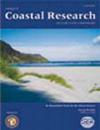澳大利亚海岸的海浪和气候变化
4区 地球科学
Q3 Earth and Planetary Sciences
引用次数: 63
摘要
HEMER, M.A.; CHURCH, J.A. and HUNTER, J.R., 2007.Waves and climate change on the Australian coast, SI 50 (Proceedings of the 9th International Coastal Symposium), 432 - 437. Gold Coast, Australia, ISSN 0749.0208.澳大利亚黄金海岸,ISSN 0749.0208。有必要对澳大利亚全境因气候变化而造成的海岸侵蚀影响进行规划。确定了澳大利亚地区的深水波浪气候,作为沿岸波浪模式的边界条件。对澳大利亚地区现有的波浪数据进行了分析,以确定平均显著波高的平均气候和年际变 化。现有数据包括 ECMWF 45 年再分析的全球波浪模式输出结果,ERA-40;修正后的 ERA-40 波高和 NOAA WaveWatch III 业务波浪模式;卫星测高数据;澳大利亚沿海内、中大陆架周围 30 个乘波浮标网和一些短期深水乘波浮标布放的数据。对这些数据进行了分析,以确定澳大利亚平均波浪气候的长期平均值、年周期和年际变化。与澳大利亚地区一些气候指数的相关性表明,南部海洋风异常是造成该地区波浪气候变异的主要机制。在澳大利亚东缘,月平均显著波浪高度与南方涛动指数之间的相关性很大。补充索引词:气候学、波浪、澳大利亚本文章由计算机程序翻译,如有差异,请以英文原文为准。
Waves and Climate Change on the Australian Coast
HEMER, M.A.; CHURCH, J.A. and HUNTER, J.R., 2007. Waves and climate change on the Australian coast, SI 50 (Proceedings of the 9th International Coastal Symposium), 432 – 437. Gold Coast, Australia, ISSN 0749.0208. There is a need to plan for the impacts of coastal erosion in response to climate change Australia-wide. A deepwater wave climatology of the Australian region is determined, which is required as boundary conditions for coastal wave models. Available wave data for the Australian region has been analysed to determine the mean climatology and interannual variability of mean significant wave height. Available data includes global wave model output from the ECMWF 45-yr re-analysis, ERA-40; corrected ERA-40 wave heights and the NOAA WaveWatch III operational wave model; satellite altimetry measurements; and data from a network of 30 waverider buoys surrounding the Australian coast located on the inner-mid continental shelf and some short-term deep-water wave-rider buoy deployments. These data have been analysed to determine the long-term mean, annual cycle and interannual variability of the mean Australian wave climate. Correlation with a number of climate indices in the Australian region indicate that southern ocean wind anomalies are a dominant mechanism responsible for variability of wave climate in the region. Correlation between monthly mean significant wave heights and the Southern Oscillation Index is significant along Australia’s eastern margin. ADDITIONAL INDEX WORDS: Climatology, waves, Australia
求助全文
通过发布文献求助,成功后即可免费获取论文全文。
去求助
来源期刊

Journal of Coastal Research
地学-地球科学综合
自引率
0.00%
发文量
87
审稿时长
3-8 weeks
期刊介绍:
The Journal of Coastal Research (JCR) is one of the leading international journals for coastal studies and processes, and is published bi-monthly by the Coastal Education & Research Foundation [CERF]. By covering the entire field of coastal research, the JCR encompasses all subjects relevant to natural and engineered environments (freshwater, brackish, or marine) and the protection/management of their resources in the vicinity of coastlines of the world. Even though the journal broadly focuses on immediate shoreline zones, the JCR also embraces those coastal environments that either reach some indefinite distance inland or that extend seaward beyond the outer margins of the sublittoral (neritic) zone. The JCR disseminates accurate information to both the public and research specialists around the world on all aspects of coastal issues in an effort to maintain or improve the quality of our planet''s shoreline resources.
 求助内容:
求助内容: 应助结果提醒方式:
应助结果提醒方式:


